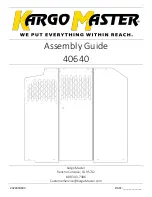
Brake Assist System (BAS)
This system complements the ABS by optimizing the
vehicle braking capability during emergency brake ma-
neuvers. This system detects an emergency braking situ-
ation by sensing the rate and amount of brake application
and then applies optimum pressure to the brakes. This
can help reduce braking distances.
Applying the brakes very quickly results in the best BAS
assistance. To receive the benefits of this system, you
must apply continuous brake pedal pressure during the
stopping sequence. Do not reduce brake pedal pressure
unless braking is no longer desired. Once the brake pedal
is released, the BAS is deactivated.
WARNING!
The BAS cannot prevent the natural laws of physics
from acting on the vehicle, nor can it increase the
traction afforded by prevailing road conditions. The
BAS cannot prevent collisions, including those re-
sulting from excessive speed in turns, driving on
very slippery surfaces, or hydroplaning. The capa-
bilities of a BAS-equipped vehicle must never be
exploited in a reckless or dangerous manner that
could jeopardize the user’s safety or the safety of
others.
368
STARTING AND OPERATING
Summary of Contents for CALIBER 2011
Page 1: ...Charger L 1...
Page 4: ......
Page 7: ...1 INTRODUCTION 5...
Page 10: ......
Page 128: ...Voice Tree 126 UNDERSTANDING THE FEATURES OF YOUR VEHICLE...
Page 159: ...Voice Tree 3 UNDERSTANDING THE FEATURES OF YOUR VEHICLE 157...
Page 160: ...158 UNDERSTANDING THE FEATURES OF YOUR VEHICLE...
Page 165: ...Voice Tree 3 UNDERSTANDING THE FEATURES OF YOUR VEHICLE 163...
Page 166: ...164 UNDERSTANDING THE FEATURES OF YOUR VEHICLE...
Page 167: ...3 UNDERSTANDING THE FEATURES OF YOUR VEHICLE 165...
Page 168: ...166 UNDERSTANDING THE FEATURES OF YOUR VEHICLE...
Page 266: ...INSTRUMENT CLUSTER 264 UNDERSTANDING YOUR INSTRUMENT PANEL...
Page 382: ...380 STARTING AND OPERATING...
Page 502: ...3 Park Turn Lamp Bulb 4 Side Marker Lamp Bulb 500 MAINTAINING YOUR VEHICLE...
Page 508: ......
Page 526: ......
Page 537: ...INDEX 10...
















































